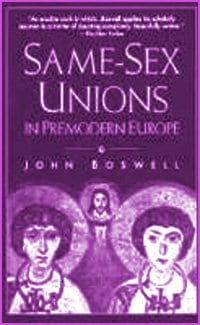Canada’s Christian Right, along with Canadian Alliance politicians, say that marriage is a gift from God to straight people. And that society has always given special status to marriage between a man and a woman because it is somehow, well, natural.
But it simply isn’t true.
One of the last century’s pre-eminent Roman Catholic historians thoroughly documented the history of same-sex Christian marriages from the eighth to 17th centuries in a book published in 1994.
John Boswell published Same-Sex Unions In Pre-Modern Europe as he was dying from AIDS. It ignited an academic debate; some religious authorities even tried, unsuccessfully, to destroy the reputation of this Yale history department chair and Fullbright scholar.
Boswell’s early sensitive and scholarly treatment of the Roman Catholic church, Christian traditions, art, theological liturgy, law, and scriptures earned him the respect of some senior Catholic scholars. They leaked the location of a millennia worth of stashed liturgies and letters documenting same-sex unions across Europe through the Middle Ages and beyond.
The hidden texts, written only in arcane tongues, had survived the Inquisition and other church purges. Knowledgeable about the social and political correctness of the time and fluent in ancient languages including Aramaic, the ancient language used in the first Christian bibles, Boswell brought to public light the early Christian acceptance of same-sex marriage.
Take, for example, the words spoken by priests in the 10th and 11th centuries:
“Merciful and loving Lord, who made man according to your image and likeness, who willed your holy apostles Philip and Bartholomew become brothers, bound to each other not by nature but faith and spirit; as your holy martyrs Sergius and Bacchus were worthy to become brothers, bless these your servants N and N; being bound together not by nature but by faith and spirit, give them peace and love and oneness of mind. Remove from their minds all stain and impurity and bring it about that they love one another as the apostles, without hate nor offence all the days of their lives. May Mother of God and all saints intercede for them. All glory is yours alone, O God.”
And “may your love become more a union of the spirit, than the flesh.”
The Church didn’t expect married gays to give up sex, but to move toward increasing spirituality as the relationship progressed.
Boswell’s book has many more examples of same-sex marriage blessings.
In Same Sex Unions and his other famous book, Christianity, Social Tolerance and Homosexuality: Gay People in Western Europe from the Beginning of the Christian Era to the Fourteenth Century (which won the American Book Award for history), Boswell documents the wording of gay ceremonies in detail. The church left behind archival letters and liturgy and details of celebration ceremonies and the consecrate pairing of men. There were rites marked by art and the evolution of a fairly standard series of prayers and symbolic gestures, including clasping of right hands bound with ermine stole, candles in left hands, kisses, crowns, circling the altar three times, and holy communion and feasts.
Boswell found same-sex union liturgies in the Vatican and Rome, London and Paris, Mount Atho and Patmos, St Petersburg, Belgrade and Istanbul, Jerusalem and the Sinai.
It appears that reserving marriage exclusively to heterosexuals is a Christian tradition of just the past three centuries.
Boswell also documents other cultures with a tradition of same-sex marriage.
“Many cultures other than Western ones have recognized and institutionalized same-sex unions,” he writes. “Japanese warriors in early modern times, Chinese men and women under the Yuan and Ming dynasties. Native American from a number of tribes (mostly before White domination), many African tribes well into the 20th century, and residents (both male and female) of the Middle East, Southeast Asia, Russia, other parts of Asia and South America.”
Don’t get Boswell wrong; he was no radical. Though harshly criticized by the Catholic Church for revealing gay state-secrets, he was also denounced by feminists for not generating material about women and savaged by gay activists who called him an apologist for Church misconduct. But the fact remains that his culminating work was two books documenting three decades of research into the history of gays in the European Middle Ages, a time when the Catholic Church reigned supreme for better and, mainly, for worse. And he hints at how the Church’s now-rabid homophobia may have first started as a power struggle by straight clergy aiming to gain ascendancy in the church hierarchy.
In one passage, Boswell turns his ascerbic wit to the subject of heterosexual marriage. “In premodern Europe (heterosexual) marriage usually began as a property arrangement, was in its middle mostly about raising children, and ended about love. By contrast, in most of the modern West, marriage begins about love, in its middle is still mostly about raising children, and ends often (more than 50 percent of heterosexual marriages in America end in divorce) about property, by which point love is absent or a distant memory.”
One cannot help but wonder whether married gays could do any worse.
SAME-SEX UNIONS IN PRE-MODERN EUROPE.
John Boswell.
Random House.
$25.

 Why you can trust Xtra
Why you can trust Xtra


